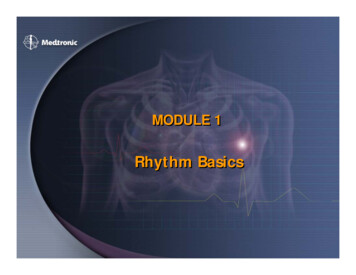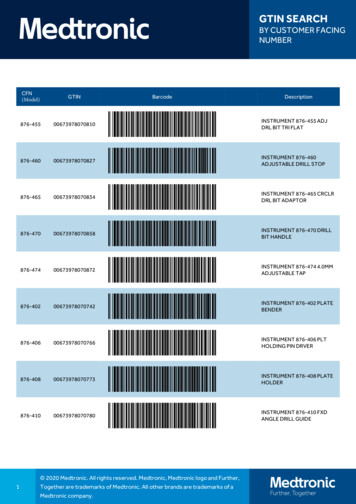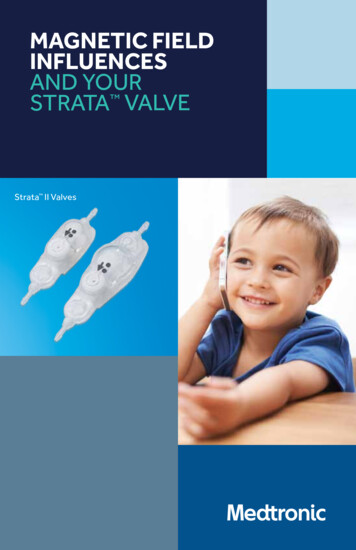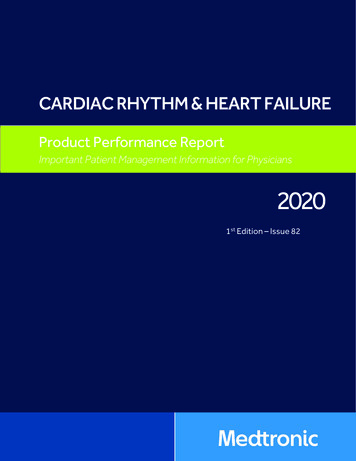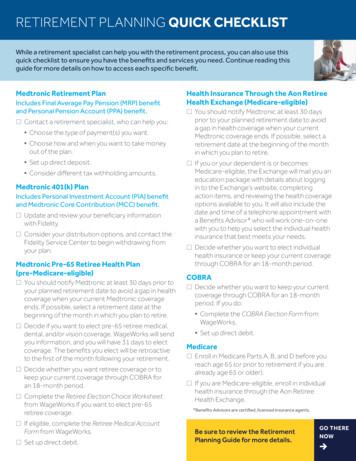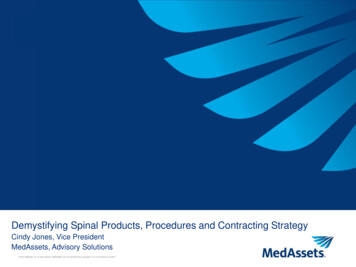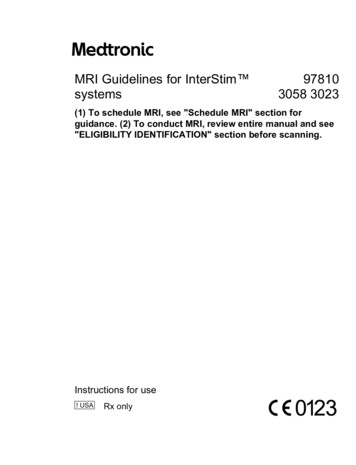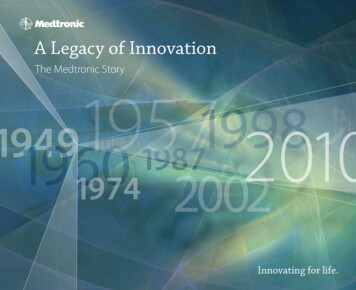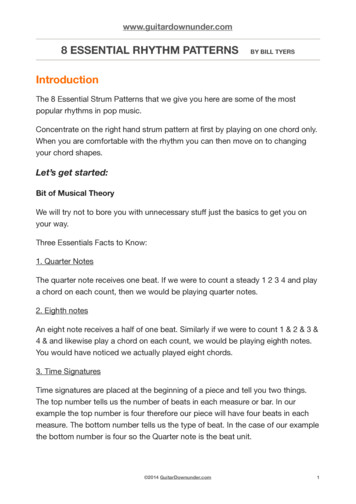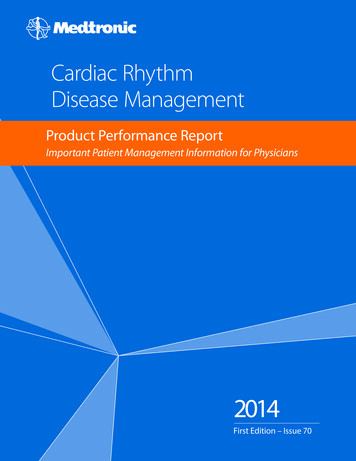
Transcription
Cardiac RhythmDisease ManagementProduct Performance ReportImportant Patient Management Information for Physicians2014First Edition – Issue 70
CRDM Product Performance Report2014 First EditionIssue 70Date cutoff for this editionis 31 January 2014 fordevices and leads dataIntroductionMethod for Estimating CRT, ICD, and IPG Device PerformanceCRTCardiac Resynchronization Therapy 14ICDImplantable Cardioverter Defibrillators 44IPGImplantable Pulse Generators 106This report is available online hod for Estimating Lead Performance 186Left-Heart Leads 191Epi/Myocardial Pacing Leads 252Defibrillation Leads 200VDD Single Pass Pacing Leads 255Pacing Leads 218ICD and CRT-D Charge Time Performance 257Advisories 269(in order of communication date, from most recent to oldest)Performance Notes 285Medtronic CRDM Product Performance Report2Data as of 31 January 2014
Our Commitment to QualityMedtronic was founded in 1949 and has grown to become a global leader in medical technology. Seeingwhat a difference medical technology could make in the lives of patients inspired our founder to developthe Medtronic Mission, which remains unchanged today.The third tenet of the mission is all about quality:“To strive without reserve for the greatest possible reliability and quality in our products, to be the unsurpassedstandard of comparison, and to be recognized as a company of dedication, honesty, integrity, and service.”Regardless of function, all CRDM employees play a role in product quality. Whether designing new therapies,sourcing components, manufacturing products, hiring talented people, assigning financial resources to projectteams, or serving in one of the hundreds of other roles, every employee has an influence on product quality.Product performance information is received from many sources through various channels. Medtronicmonitors information from many sources from Research and Development through Manufacturing andField Performance Vigilance.When a device is returned to Medtronic, laboratory technicians and engineers assess overall device function.Analysis of returned product is performed according to written procedures. These procedures determine theminimum analysis required. The analysis required varies depending on the type of device, age of the device,the associated information received with the device, actual experience with models of similar design, and otherfactors. Additional analysis is performed as necessary to investigate a performance concern from a customer,or to collect specific reliability data.When a malfunction is identified, failure analysis is performed to provide the detailed information necessaryto investigate possible causes and actions. Medtronic CRDM maintains in-house expertise and performs itsfailure analysis using facilities it owns and supports. This capability permits detailed failure analysis.Analysis results are compared to original manufacturing records and design intent. Clinical observations areadded to laboratory findings to help determine root cause. Each event is then compared to other events. If apattern is detected, actions are taken to identify a common root cause, assess patient risk and an appropriatecourse of action.Medtronic instituted the industry’s first product performance reports in 1983 by publishing data on ourchronic lead studies. Pacemakers and other devices followed as our performance reporting has constantlyevolved based on customer needs and feedback. One thing has been a constant. It is our sincere commitmentto communicate clearly, offering timely and appropriate product performance data and reliability information.This has always been and will continue to be our goal.Tim SamselVice President, Quality and RegulatoryMedtronic Cardiac Rhythm Disease ManagementMedtronic, Inc.Medtronic CRDM Product Performance Report3Data as of 31 January 2014
Contact InformationWe invite our customers to use these telephone numbers to call withsuggestions, inquiries, or specific problems related to our products.US Technical Services DepartmentInternational Technical CentersPhone: 1 (800) 723-4636 (Tachy)1 (800) 505-4636 (Brady)Fax: 1 (800) ope (Heerlen NL)Japan (Tokyo)For questions related to this CRDM ProductPerformance Report, please call US Technical Servicesat the number above, or write to:For questions related to returning explantedproduct or returning product that shows signs ofmalfunction, please contact:Chris HaenischMedtronic, Inc.8200 Coral Sea Street NE MVN61Mounds View, MN 55112 USA 31-45-566-8844 81-3-6430-7026Outside the United States:Your Medtronic representative or international technical center atthe number above.Within the United States:Your Medtronic representative orEmail: chris.m.haenisch@medtronic.comCRDM Returned Product Analysis LaboratoryPhone:Email:Editorial StaffTrademarks of Medtronic, Inc.Independent Physician Quality PanelAdapta Advisa Advisa DR MRI AT500 Attain Attain Ability Attain StarFix CapSure CapSure Sense CapSureFix CapSureFix Novus CaptureManagement CareLink Concerto Consulta EnPulse EnRhythm EnRhythm MRI Ensura MRI EnTrust EnTrust MRI GEM InSync InSync ICD InSync Marquis Steven J. Compton, MD, Anchorage, AKJohn P. DiMarco, MD, PhD, Charlottesville, VAKevin Hackett, MD, Columbus, OHR. Hardwin Mead, MD, Palo Alto, CAN.A. Mark Estes, MD, Boston, MAAndrew Krahn, MD, Vancouver, BCEditorTim Samsel, Vice President, CRDM Quality and RegulatoryMedtronic CRDM Product Performance Report1 (800) 328-2518, ext. 44800crdm.returnedproduct@medtronic.com4InSync II Marquis InSync III Marquis InSync Maximo InSync IIProtect InSync IIIProtect InSync Sentry Intrinsic Jewel Kappa Legend Marquis Maximo MedtronicCareAlert MedtronicCareLink Micro JewelMicro MinixMinixMinuetMVP Onyx Patient Alert PrevaPrevail ProdigyProtecta Quick Look Relia Revo MRI Secura SelectSecure Sensia Sensing AssuranceSigma SpectraflexSprint Sprint Fidelis Sprint Quattro Sprint QuattroSecure Sprint QuattroSecure S SureFix Syncra Target Tip TenaxThera -iTransveneVersa Virtuoso Data as of 31 January 2014
IntroductionAll product performance reports are not created equal. For 30 years, Medtronic hasmonitored performance via both returned product analysis and multicenter clinical studies.This Product Performance Report (PPR) presents devicesurvival estimates, advisory summaries, performancenotes, and other information pertinent to assessing theperformance of Medtronic implantable pulse generators(IPGs), implantable cardioverter defibrillators (ICDs),cardiac resynchronization therapy (CRT) devices, andimplantable pacing and defibrillation leads.The actuarial life table method is applied to the datacollected for CRT, ICD, and IPG devices and leads toprovide the survival estimates included in this report.A general introduction to understanding this methodof survival analysis is given later in this introduction.This Product Performance Report has been preparedin accordance with International Standard ISO5841- 2:2000(E).Since May 2000, Medtronic has provided importantinformation on charge time performance of ICDs.The information provided in this report shows howICD charge time can vary during the time a device isimplanted. The information is presented in graphicalformat showing charge time as a function of implanttime. The data for charge times are collected fromdevices enrolled in the Product Surveillance Registry.ICD Charge TimesThe survival estimates provided in this report areconsidered to be representative of worldwide performance.Survival EstimatesMedtronic, like other companies, monitors CRT, ICD, andIPG device performance using returned product analysis.We also monitor CRT, ICD, and IPG device performanceusing an active multicenter clinical study.Advisory SummariesThis Product Performance Report includes summariesof all advisories applicable to the performance of theproducts included in the report. An advisory is addedto the report when any product affected by the advisoryremains in service and at risk of experiencing thebehavior described in the advisory. The advisory willremain in the report until Medtronic estimates noproduct affected by the advisory remains active, orthe risk of experiencing the behavior described in theadvisory has passed.Returned product analysis is a passive approach toassessing product performance. This approach providesa suitable measure of product performance only when asignificant number of explanted products are returnedto the manufacturer. Returned product analysisprovides a measure of hardware performance, but notnecessarily the total clinical performance (e.g., theincidence of complications such as infection, erosion,muscle stimulation, etc. are not estimated).For most advisories, the products subject to theadvisory retain essentially the same survival probabilityas the products of the same model(s) not affectedby the advisory. For those advisories where thesurvival probabilities of the affected and non-affectedpopulations do differ significantly, Medtronic willprovide separate survival data for each population. Theseparate survival data will remain in the report untilMedtronic estimates no affected product remains inactive service.The survival estimates provided in this report forCRT, ICD, and IPG devices are based on returned productanalysis. This approach is suitable because a significantnumber of explanted generators are returned foranalysis.Lead performance is monitored differently. Incontrast to CRT, ICD, and IPG devices, a very smallpercentage of leads are returned to the manufacturerdue to the difficulty of explanting them. For leads, anactive clinical study provides more accurate survivalestimates compared to estimates based solely onreturned product analysis.Performance NotesThis report concludes with a number of PerformanceNotes developed by Medtronic to provide additionalproduct performance information relevant to follow-uppractice and patient management.Survival estimates for leads are based on clinicalobservations recorded via Medtronic CRDM’s SystemLongevity Study. This multicenter clinical study isdesigned to record clinical observations representativeof the total clinical experience. Therefore, the leadsurvival estimates include both lead hardware failureand lead-related medical complications, and do notdifferentiate a lead hardware failure from other clinicalevents such as exit block, perforation, dislodgement, orconcurrent pulse generator failure.Medtronic CRDM Product Performance Reportcontinued5Data as of 31 January 2014
IntroductioncontinuedMedtronic urges all physicians to return explanted products and to notify Medtronicwhen a product is no longer in use, regardless of reason for explant or removal from use.How You Can HelpCRT, ICD, and IPG devices is made up of patients whosedevices are registered as implanted in the United States.For leads, the population sample is the patients enrolledin our multicenter, international prospective ProductSurveillance Registry.Medtronic urges all physicians to return explantedproducts and to notify Medtronic when a product isno longer in use, regardless of the reason for explantor removal from use. The procedures for returningproducts vary by geographic location.For IPGs and ICDs, the events can be normal batterydepletion or a device malfunction. For leads, the eventsare complications as defined in the study protocol.Mailer kits with prepaid US postage are available foruse within the United States to send CRTs, ICDs, IPGs,and leads to Medtronic’s CRDM Returned ProductAnalysis Lab. These mailers are sized to accommodatethe devices and leads from a single patient or clinicalevent and are designed to meet US postal regulationsfor mailing biohazard materials.The actuarial life table method allows Medtronic toaccount for devices and leads removed from servicefor reasons unrelated to performance and for deviceand leads still in service. Devices and leads removedfor reasons unrelated to performance or are still inservice are said to be suspended. Examples of devicesand leads removed from service for reasons unrelated toperformance include:If the product being returned is located outside theUnited States, please contact your local Medtronicrepresentative for instructions. Medtronic also requests the return of explantedproducts from non-clinical sources, such as funeralhomes, and will assume responsibility for storage anddisposal of the product once received. removed to upgrade the device or lead o longer in service due to the death of the patient fornreasons unrelated to the device or leadsimplanted in patients who are lost to follow-upMailer kits can be obtained by contacting the ReturnedProduct Lab. For information on how to contact the Lab,refer to the Contact Information page of this report.For each suspension, the device or lead has performedwithin performance limits for a period of time, afterwhich its performance is unknown.We continually strive to improve this CRDM ProductPerformance Report. In keeping with this philosophy,we ask for your suggestions on the content and formatof this report, as well as any information you haveregarding the performance of Medtronic products. Forinformation on how to comment on this report, see theContact Information page of this report.An ExampleThe following example describes the survival analysismethod used to establish the survival probabilityestimates for Medtronic CRDM devices and leads. Theexample is intended to provide an overview of theanalysis process. The definitions of malfunctions andcomplications, and other details specific to calculatingdevice and lead survival estimates, are provided in thearticles Method for Estimating CRT, ICD, and IPG DevicePerformance (page 6) and Method for Estimating LeadPerformance (page 74).Overview of Survival AnalysisMedtronic uses the Cutler-Ederer actuarial life tablemethod to estimate the length of time over whichdevices and leads will perform within performancelimits established by Medtronic. This probability toperform within performance limits over time is calledthe survival probability.continuedDevices and leads are followed until an event occurswhere the device or lead ceases to operate withinperformance limits. The length of time from implantto the event is recorded for individual devices and leadsin the population sample. The population sample forMedtronic CRDM Product Performance Report6Data as of 31 January 2014
IntroductioncontinuedThis simple example describes the survival analysis method used to establishthe survival probability estimates for Medtronic CRDM devices and leads.Figure 1The number of devices entered, suspended, andremoved due to an event are counted and summarized,as shown in Table 1. For the first two intervals, all16 devices survived and none were removed. In theinterval (24-36 months), device BH004134 wasremoved due to an event. Therefore the table entriesshow that 16 entered the interval, none were suspended,and one was removed due to an event.Implant times for devices of 16 patients. Gray bars with a yellowX indicate devices removed from service due to an event. Bluebars indicate suspended devices.EventTime (months)Suspended0 12 24 36 48 60 72 84 96 108 120 132For the interval from 36-48 months, only 15 devicesentered the interval and one was removed for an event.The remaining intervals are examined and the dataentered in columns A, B, and C in like manner. The restof the columns are filled in using calculations on thedata in columns A, B, and C.BH004134BH002883BH006049BH008926BH007561The Effective Sample Size (D) is the number of deviceswith full opportunity to experience a qualifying eventin the interval. This is computed by subtracting onehalf the number suspended in the interval from thenumber that entered the interval. This calculationmore accurately reflects the number of devices thatcould have experienced a qualifying event than simplyusing the number that entered the interval. Using thenumber of devices that enter an interval overestimatesthe sample size because the suspended devices do notcomplete the interval. Ignoring the suspended devicesunderestimates the sample size because suspendeddevices are not credited with their full service time.Using one half the number of suspended deviceseffectively splits the difference.Serial 6508BH011313BH012373BH007977BH012011BH005863The next column in the table is the Proportion with Event(E). This is the proportion of devices that had an eventin the interval. It is calculated by dividing the Numberof Events (C) by the Effective Sample Size (D). The numbercan be interpreted as the estimated rate at which eventsoccur in the time interval.Figure 1 illustrates 16 patients who have implanteddevices. The first patient’s device (serial numberBH004134) operated within performance limits for32 months. At that time an event occurred. The fourthpatient’s device (serial number BH008926) did nothave an event but is suspended, perhaps because it wasstill in service at the time of the analysis. This patienthad 66 months of implant experience. In this example,Figure 1 shows that seven of the 16 devices sufferedevents, and nine are suspended.The Interval Survival Probability (F) is the estimateof probability of surviving to the end of the intervalassuming the device was working at the beginning ofthe interval. It is calculated as 1 minus the Proportionwith Event (E). This number can be interpreted as theestimated rate at which events do not occur in the timeinterval.The first step in the life table method is to dividethe implant time into intervals of a specific length.This example will use 12-month intervals.Medtronic CRDM Product Performance Reportcontinued7Data as of 31 January 2014
IntroductioncontinuedThe Cumulative Survival Probabilities (G) from the last column of the life tablecan be plotted versus time intervals in the first column to give a survival curve.Figure 2 shows the survival curve for the data shown in Table 1.Table 1Life Table for Figure 1ABCDEFGCumulativeSurvivalProbabilityIntervalin MonthsNumberEnteredNumberSuspendedNumberof EventsEffectiveSample SizeProportionwith ns:ABCDEFGNumberEnteredNumberSuspendedNumberof EventsEffectiveSample SizeProportionwith EventNumber of devicesactive at the startof the intervalNumber of devicesremoved fromservice for reasonsother than aneventNumber of unitsremoved fromservice due to aneventNumber ofunits with fullopportunity toexperience aqualifying eventin the interval.Computed bysubtracting onehalf the NumberSuspended fromthe NumberEntered.Proportion ofdevices thathad an eventin the interval.Computed bydividing theNumber of Eventsby the EffectiveSample ProbabilityThe probabilityof surviving tothe end of theinterval, assumingthe device wasworking at thebeginning ofthe interval.Computed as1 minus theProportion WithEvent.The overallprobability ofsurviving to theend of the interval.Computed bymultiplying theInterval SurvivalProbability by theprevious ve Survival Probability (G) is the estimateof the unconditional probability of surviving to theend of the interval. It is computed by multiplying theInterval Survival Probability (F) by the previous interval’sCumulative Survival Probability. The probability ofsurviving to 132 months in the example is estimated forthe table to be 0.341, or 34.1%.Medtronic CRDM Product Performance ReportThe Cumulative Survival Probabilities (G) of the life tablecan be plotted versus time intervals in the first columnto give a survival curve. Figure 2 shows the survivalcurve for the data in Table 1.continued8Data as of 31 January 2014
IntroductionCumulative Survival Probability (%)Figure 2continuedSurvival Curve for Data Given in Table 11009080706050403001224364860728496108120132Time (months)12% 0# 100 100161624364860728496108 120132100 93.8 87.5 81.3 68.3 68.3 68.3 34.1 34.1 34.11616151412.596.5410.5Effective Sample SizeConfidence IntervalsSurvival Curves in the ProductPerformance ReportSince survival curves are based on a sample of thedevice and lead population, they are only estimates ofsurvival. The larger the effective sample size, the moreconfident the estimate. A confidence interval can becalculated to assess the confidence in an estimate. Inthe Product Performance Report, Medtronic providesa 95% confidence interval. This can be interpreted asmeaning that 95% of the time, the true survival of thedevice will fall somewhere in the interval.Since the survival estimate can become very imprecisewith small effective sample sizes, Medtronic truncatesthe survival curve when the effective sample sizeis less than 100 for CRTs, ICDs, and IPGs, and when thenumber entered is less than 50 for leads. The survivalcharts in the Product Performance Report show theeffective sample size for each year interval whereMedtronic has experience. When the effective samplesize reaches 100 for CRTs, ICDs, and IPGs or when thenumber entered reaches 50 for leads, the next datapoint is added to the survival curve.Although the report provides tabular data in one-yearintervals, the curves are actually computed and plottedusing 1-month intervals (for CRT, ICD, and IPG devices)or 3-month intervals (for leads).A number of references are available for additionalinformation on survival analysis using the CutlerEderer life table method.11Medtronic CRDM Product Performance Report9 ee, Elisa T.(2003) Statistical Methods for Survival Data Analysis –L3rd Edition (Wiley Series in Probability and Statistics).Data as of 31 January 2014
Method for Estimating CRT, ICD, and IPG Device PerformanceMedtronic urges all physicians to return explanted products and to notify Medtronicwhen a product is no longer in use, regardless of reason for explant or removal from use.The performance of CRT, ICD, and IPG devices isexpressed in terms of device survival estimates,where “survival” refers to the function of the device, notthe survival of the patient. These survival estimatesare intended to illustrate the probability that a devicewill survive for a given number of years with neithermalfunction nor battery depletion.Not all malfunctions expose the patient to a loss ofpacing or defibrillation therapy. Some malfunctionsincluded in the following survival estimates may nothave been detected at all by the physician or the patient.These malfunctions, however, are included in thesurvival estimates and provide important feedback toour product development organization.The survival estimates are determined from theanalysis of Medtronic CRDM’s United States deviceregistration data and US returned product analysis data.These data are presented graphically and numerically.To provide insight into the nature of malfunctions,each malfunction is categorized as Malfunction withCompromised Therapy Function or Malfunctionwithout Compromised Therapy Function.Because this analysis is based on returned productanalysis, the performance data does not reflect anydevice-related medical complications such as erosion,infection, muscle stimulation, or muscle inhibition.For this report, Normal Battery Depletion, Malfunctionwith Compromised Therapy Function, and Malfunctionwithout Compromised Therapy Function are defined asfollows:Categorization of Depleted andMalfunctioning Devices for Survival AnalysisFor survival estimation, every device returned toMedtronic CRDM and analyzed in the CRDM ReturnedProduct Analysis laboratory is assigned to one of threecategories. The device 1) is functioning normally,2) has reached normal battery depletion, or 3) hasmalfunctioned. This categorization is combined withdata from our device registry for the total numberof implants and the implant durations to create thesurvival curves presented on the following pages.Definition of MalfunctionMedtronic CRDM considers a device as havingmalfunctioned whenever the analysis shows thatany parameter was outside the performance limitsestablished by Medtronic while implanted and inservice. To be considered a malfunction or batterydepletion, the device must have been returned toMedtronic and analyzed.Devices damaged after explant, damaged due to failureto heed warnings or contraindications in the labeling,or damaged due to interaction with other implanteddevices (including leads) are not considered devicemalfunctions.Normal Battery Depletion – The condition when:(a) a device is returned with no associated complaintand the device has reached its elective replacementindicator(s) with implant time that meets orexceeds the nominal (50 percentile) predictedlongevity at default (labeled) settings, or(b) a device is returned and the device has reached itselective replacement indicator(s) with implant timeexceeding 80% of the expected longevity calculatedusing the available device setting information.Medtronic CRDM establishes expected longevity bystatistically characterizing the power consumed bythe device and the power available from the devicebattery. This characterization is applied to a numberof parameter configurations to derive a statisticalmean longevity value and standard deviation for eachparameter configuration. The statistical mean valueminus three standard deviations is used as the expectedlongevity for determining if a battery depleted normally.continuedA device subject to a safety advisory is not consideredto have malfunctioned unless it has been returnedto Medtronic CRDM and found, through analysis, toactually have performed outside the performance limitsestablished by Medtronic.Medtronic CRDM Product Performance Report10Data as of 31 January 2014
Method for Estimating CRT, ICD, and IPG Device PerformancecontinuedThe Standard Actuarial Method is used to estimate IPG and ICD survival. This productperformance report has been prepared in accordance with International StandardISO 5841-2:2000(E).For reference purposes, the following pages includeestimated longevities for each model. The actuallongevity achieved for any device while implanted willdepend on the actual programmed parameters andpatient factors, and may differ significantly fromthese estimates.Malfunction with Compromised Therapy FunctionThe condition when a device is found to havemalfunctioned in a manner that compromised pacingor defibrillation therapy (including complete loss orpartial degradation), while implanted and in service, asconfirmed by returned product analysis.Examples: Sudden loss of battery voltage; accelerated current drainsuch that low battery was not detected before loss of therapy; suddenmalfunction during defibrillation therapy resulting in aborted deliveryof therapy, intermittent malfunction where therapy is compromisedwhile in the malfunction state.Malfunction without Compromised Therapy FunctionThe condition when a device is found to havemalfunctioned in a manner that did not compromisepacing or defibrillation therapy, while implanted and inservice, as confirmed by returned product analysis.Examples: Error affecting diagnostic functions, telemetry function,data storage; malfunction of a component that causes battery to losepower quickly enough to cause premature battery depletion, but slowlyenough that the condition is detected through normal follow-up beforetherapy is lost; mechanical problems with connector header that do notaffect therapy.Expanded Malfunction DetailThe malfunctions are further divided into categoriesthat identify the subject area of the malfunction.The malfunctions are divided into the followingsubject areas:Electrical Component – Findings linked to electricalcomponents such as integrated circuits, resistors,capacitors, diodes, etc.Electrical Interconnect – Findings linked to theconnections between electrical components such aswires, solder joints, wire bonds, etc.Possible Early Battery Depletion – Findings wherethe actual reported implant time is less than 80% ofthe expected longevity calculated using the availabledevice setting information with no device malfunctionobserved. There may not be sufficient device settinginformation to determine conclusively if batterydepletion was normal or premature in the absence of aspecific root cause finding. However, returned devicesmeeting the above criteria are conservatively classifiedas Possible Early Battery Depletion malfunctions.Other – Findings related to other components such asinsulators, grommets, setscrews, and packaging, andfindings where analysis is inconclusiveReturned Product Analysis ProcessAnalysis of returned product is performed accordingto written procedures. These procedures determinethe minimum analysis required. The analysis requiredvaries depending on the type of device, age of thedevice, the associated information received with thedevice, actual experience with models of similar design,and other factors. Additional analysis is performed asnecessary to investigate a performance concern from acustomer, or to collect specific reliability data.When a device is returned with a performance concernfrom a customer, the general analysis process includesa preliminary analysis of the device in its as-receivedcondition, followed by an automated functional testusing test equipment equivalent to the equipment usedin manufacturing.When a malfunction is identified, failure analysisis performed to provide the detailed informationnecessary to investigate possible causes and actions.Medtronic CRDM maintains in-house expertiseand performs its failure analysis using facilities it ownsand supports. This capability permits detailedfailure an
Medtronic estimates no affected product remains in active service. Performance Notes. This report concludes with a number of Performance Notes developed by Medtronic to provide additional product performance information relevant to follow-up practice and patient management. continued. Medtronic CRDM Product Performance Report 5 Data as of 31 .

